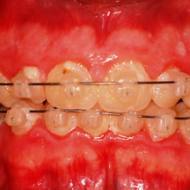ORTHODONTICS
It is that particular branch of dentistry that studies the various anomalies, the development and the position of the teeth and jaw bones. Performed exclusively by dentists and specialists in orthodontics, it is intended to prevent, eliminate or reduce such anomalies while maintaining or restoring the mastication organs and facial profile in the most correct position possible.
The orthodontic practice consists substantially in two types of therapy, which can be consequential.
Fixed orthodontics
Is implemented through the design and application of different types of equipment that could be divided into:
Active devices: they act directly with their strength when they are activated (e.g. devices with screws, arches, springs, etc.)
Passive devices: they exploit the masticatory forces being per se inactive (e.g. buccal plate, inclined plane, etc.).
Mobile orthodontics
Is carried out with removable devices of various shapes that can be easily removed by the patient. Often mobile orthodontics is the first phase of the treatment and is used in order to widen or narrow the palate, to correct the bite or retainer.
Invisalign (invisible aligners)
It consists of a series of devices (aligner) that are removable and almost invisible, which are replaced every two weeks by a new set provided by the dentist. Each aligner is individually manufactured exclusively for the patient’s teeth. When the invisible devices are applied and replaced in the subsequent weeks, the teeth will move little by little, week by week, until they have straightened to the final position prescribed by the dentist and agreed with the patient on a computer.
Orthodontic surgery
It is implemented, in milder form, extracting those teeth that hinder the alignment and articulation of others or the correct dentofacial position and then the orthodontic treatment is applied. In more complex cases, when the simple fixed orthodontic treatment is not sufficient to restore the facial bones (maxilla and mandible) in the correct proportions, we proceed with orthognathic surgery. First, however, it is always required to apply a pre-surgical fixed orthodontic treatment that aligns the teeth in relation to the movement of the bony structures. Orthognathic surgery is also indicated to address other issues such as: open bite (inability to close the teeth), small jaw and chin backward, prognathism with reverse bite, “sleep apnea” and all the breathing difficulties during sleep and snoring caused by a small or retracted jaw, facial and mandibular asymmetry, inability to close the lips without effort, difficulty biting and chewing, difficulty swallowing and speaking, chronic pain in the jaw and headaches.
Preprosthetic orthodontics
It is a treatment that allows the application of a future denture on teeth or abutments previously inclined and correctly aligned after the preprosthetic orthodontic treatment. These devices are always different from each other, because they are built to suit the anatomy of very different arches. It is essential that the teeth to be aligned do not have a periodontal disease.

